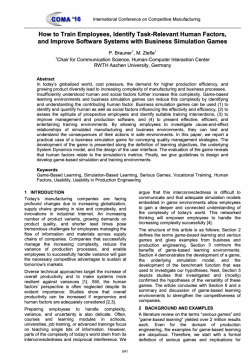
Abstract
In today’s globalized world, cost pressure, the demand for higher production efficiency, and growing product diversity lead to increasing complexity of manufacturing and business processes. Insufficiently understood human and social factors further increase this complexity. Game-based learning environments and business simulation games can reduce this complexity by identifying and understanding the contributing human factor. Business simulation games can be used (1) to identify and quantify human as well as social factors influencing the effectivity and efficiency, (2) to assess the aptitude of prospective employees and identify suitable training interventions, (3) to improve management and production software, and (4) to present effective, efficient, and entertaining training environments. By allowing employees to investigate cause-and-effect relationships of simulated manufacturing and business environments, they can test and understand the consequences of their actions in safe environments. In this paper, we report a practical case of a business simulation game for conveying quality management strategies. The development of the game is presented along the definition of learning objectives, the underlying System Dynamics model, and the design of the user interface. The evaluation of the game reveals that human factors relate to the simulation’s metrics. Finally, we give guidelines to design and develop game-based simulation and training environments.
Brauner, P., Ziefle, M.: How to Train Employees, identify Task-relevant Human Factors, and Improve Software Systems with Business Simulation Games. In: Dimitrov, D. and Oosthuizen, T. (eds.) Proceedings of the 6th International Conference on Competitive Manufacturing 2016 (COMA ’16). pp. 541–546. CIRP, Stellenbosch, South Africa (2016).
Related Project(s):
